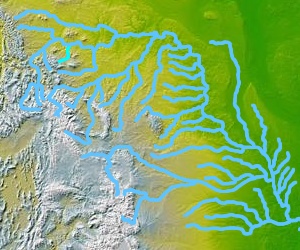Judith River facts for kids
Quick facts for kids Judith River |
|
|---|---|

Judith River near Hanover Road
|
|

The Judith River
|
|
| Country | Fergus and Judith Basin County, Montana |
| Physical characteristics | |
| Main source | 46°50′57″N 110°16′10″W / 46.84917°N 110.26944°W |
| River mouth | 2,408 feet (734 m) 47°44′06″N 109°38′46″W / 47.73500°N 109.64611°W |
| Basin features | |
| River system | Missouri River |
| Tributaries |
|
The Judith River is a river in central Montana, United States. It is about 124 miles (200 km) long. The river is a tributary of the Missouri River, which means it flows into the Missouri River.
The Judith River starts in the Little Belt Mountains. It then flows northeast, passing towns like Utica and Hobson. It joins another stream called Dry Wolf Creek in Fergus County. Finally, the Judith River flows into the Missouri River in the White Cliffs Area. This is about 18 miles (29 km) northwest of Winifred.
Dinosaur Discoveries
The Judith River is famous for its connection to dinosaur fossils. The area around the river is part of something called the Judith River Group. This is a special rock formation from the late Cretaceous period.
This area is a very important place for finding dinosaur fossils. It stretches from Montana into parts of Canada, like Alberta and Saskatchewan. Many different dinosaur fossils have been found here. These include parts of huge dinosaurs like Tyrannosaurus, Styracosaurus, and Edmontosaurus.
River Access
The Judith River is open to the public for fun activities like fishing or boating. This is true for the part of the river from where Big Spring Creek joins it, all the way to where it meets the Missouri River. This part of the river is known as a Class I river for public access.
History of the River
Native American tribes lived near the Judith River for a very long time. The Crow tribe had their own name for this waterway. They called it Buluhpa’ashe, which means “Plum River.”
Later, explorers came to the area. In 1805, Captain William Clark, who was part of the famous Lewis and Clark Expedition, renamed the river. He thought the stream was very clear and beautiful. He decided to name it the Judith River to honor his cousin, Julia Hancock.
In the 1880s, the land around the Judith River became home to large cattle ranches. Two of the biggest were the DHS Ranch and the PN Ranch. Important people like Samuel T. Hauser and Granville Stuart were involved with these ranches.
A significant event in the area's history happened in 1881. White Eagle, who was the last main Chief of the Gros Ventre people, passed away near where the Judith River meets the Missouri River.
See also
 In Spanish: Río Judith para niños
In Spanish: Río Judith para niños

